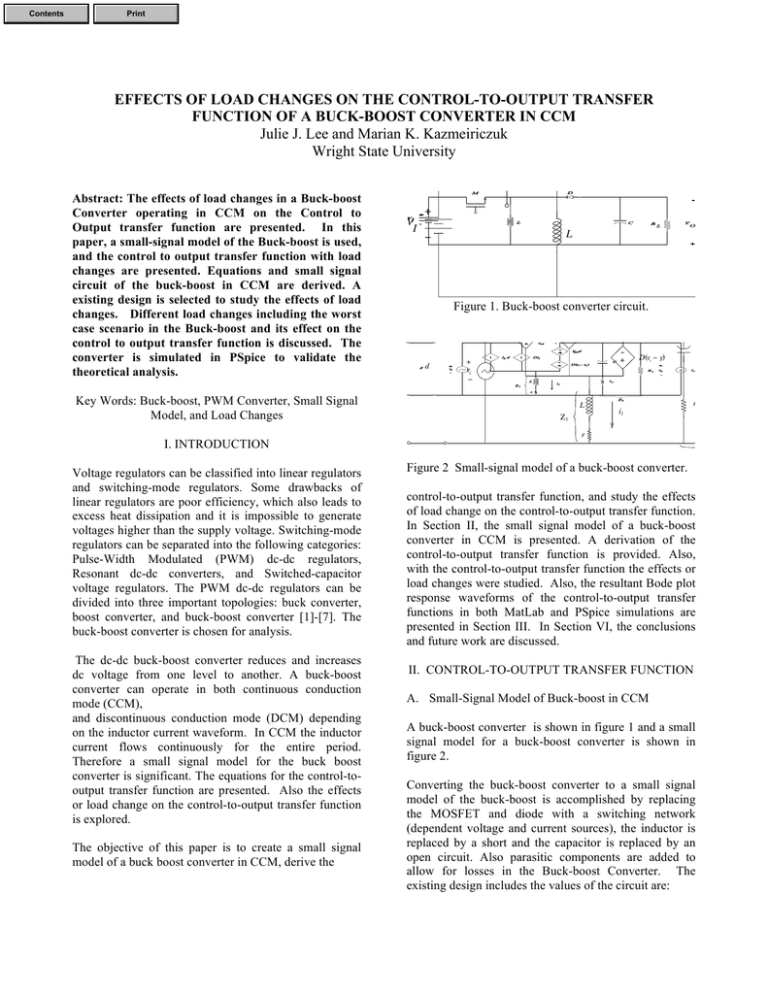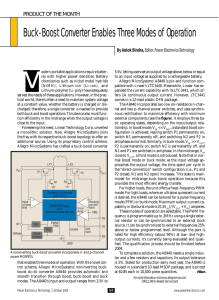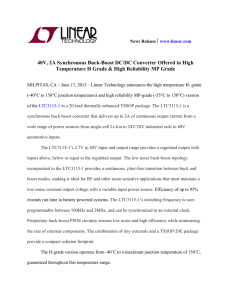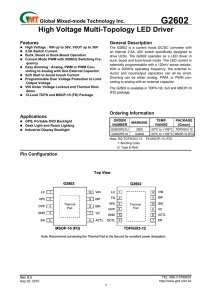Effects of Load Changes on the Control-to-output
advertisement

Contents Print EFFECTS OF LOAD CHANGES ON THE CONTROL-TO-OUTPUT TRANSFER FUNCTION OF A BUCK-BOOST CONVERTER IN CCM Julie J. Lee and Marian K. Kazmeiriczuk D M Wright State University Abstract: The effects of load changes in a Buck-boost Converter operating in CCM on the Control to Output transfer function are presented. In this paper, a small-signal model of the Buck-boost is used, and the control to output transfer function with load changes are presented. Equations and small signal circuit of the buck-boost in CCM are derived. A existing design is selected to study the effects of load changes. Different load changes including the worst case scenario in the Buck-boost and its effect on the control to output transfer function is discussed. The converter is simulated in PSpice to validate the theoretical analysis. Key Words: Buck-boost, PWM Converter, Small Signal Model, and Load Changes I. INTRODUCTION Voltage regulators can be classified into linear regulators and switching-mode regulators. Some drawbacks of linear regulators are poor efficiency, which also leads to excess heat dissipation and it is impossible to generate voltages higher than the supply voltage. Switching-mode regulators can be separated into the following categories: Pulse-Width Modulated (PWM) dc-dc regulators, Resonant dc-dc converters, and Switched-capacitor voltage regulators. The PWM dc-dc regulators can be divided into three important topologies: buck converter, boost converter, and buck-boost converter [1]-[7]. The buck-boost converter is chosen for analysis. The dc-dc buck-boost converter reduces and increases dc voltage from one level to another. A buck-boost converter can operate in both continuous conduction mode (CCM), and discontinuous conduction mode (DCM) depending on the inductor current waveform. In CCM the inductor current flows continuously for the entire period. Therefore a small signal model for the buck boost converter is significant. The equations for the control-tooutput transfer function are presented. Also the effects or load change on the control-to-output transfer function is explored. The objective of this paper is to create a small signal model of a buck boost converter in CCM, derive the ! V I L ! C *0& /% R ! Figure 1. Buck-boost converter circuit. $%%& ' & + (%%& )! + ( " +) !%*%!%* !"# / *" ! . / , ' *+ ! ' Z1 "# -. - Figure 2 Small-signal model of a buck-boost converter. control-to-output transfer function, and study the effects of load change on the control-to-output transfer function. In Section II, the small signal model of a buck-boost converter in CCM is presented. A derivation of the control-to-output transfer function is provided. Also, with the control-to-output transfer function the effects or load changes were studied. Also, the resultant Bode plot response waveforms of the control-to-output transfer functions in both MatLab and PSpice simulations are presented in Section III. In Section VI, the conclusions and future work are discussed. II. CONTROL-TO-OUTPUT TRANSFER FUNCTION A. Small-Signal Model of Buck-boost in CCM A buck-boost converter is shown in figure 1 and a small signal model for a buck-boost converter is shown in figure 2. Converting the buck-boost converter to a small signal model of the buck-boost is accomplished by replacing the MOSFET and diode with a switching network (dependent voltage and current sources), the inductor is replaced by a short and the capacitor is replaced by an open circuit. Also parasitic components are added to allow for losses in the Buck-boost Converter. The existing design includes the values of the circuit are: 12 Contents Print This leads to the final equation for the input control to output transfer function . The dependent sources are related to duty cycle. Setting the other two inputs to zero relates the control input to the output. This transfer function due to duty cycle affecting the output is Tp. The derivation using figure 2 of Tp is below starting from first principles of KCL and KVL. Using KCL first find the current at the inductor node: . (1) (6) where Use KVL find an equation for inductor current in terms of output voltage and duty cycle. . . Now substitute equation into the previous equation using KCL. . (2) Use algebra and rearrange values to separate into output voltage and duty cycle. The input control to output voltage transfer function is a second-order low-pass filter. It is a non-minimum phase system due to the right hand plane zero. When duty cycle D is increased from 0 to 1, the zero moves from infinity to the jw=0 axis and then back toward infinity. The complex pole of the system is also dependent on duty cycle D. The duty cycle D should be kept a distance away from one to keep efficiency of the Buck-boost at a high level. B. Effects of Load Changes on Control-to-Output Transfer Function. Now dividing output by duty cycle give the transfer function . The values for and (3) are DC therefore the Buck-boost was converted to a DC model and expressions for these values were found with know values. These values were substituted into the input control to output voltage transfer function. (4) and . (5) Load fluctuations occur for a variety of reasons which affects the output voltage of the system. Three different loads were chosen to experiment with the effects of load fluctuation on the output-to-control transfer function. The values of the different loads are chosen to show a range of the different results on voltage due to the load fluctuation. The chosen values are the original load of 14 ohms, double the calculated load, and the worst case scenario of ten times the load. The effects of the output to input control transfer function was demonstrated by the transient response and frequency response. The theoretical transient response of the input control to output voltage with only the normal calculated load is shown in figure 3. Figure 4 shows the simulated results including load fluctuation from the normal load to the worst case scenario. The peak voltage Contents Print ) linearized circuits. Therefore, a sinusoidal source was &" inserted, and R 0!%! ! %" #1! !%"! $" !') #" !#! ,Tp','(-.'/+ vO*+/. !'! !#) !(! !" " !!" !() !$! ' L !) !#" ! !"!!# !"!!$ !"!!% !"!!& !$" !"!' t*+,-. !%" ' " !" Figure 3. Output Voltage of buck-boost with regular load. ! # !" $ !" % !" & !" !" f'()*+ Figure 5. Magnitude Bode plot with load of 14, 28 and 140 Ω. !)" * RL/!%" !&" #)" !%"" !#" (" p !T *+!. '" $" " !$" !(" Figure 4. Output voltage of buck-boost when load is regular then worst case senerio. !'" * ! !" # !" $ !" f*+,-. % !" Figure 6. Phase Bode plot with load of 14, 28 and 140 Ω. was -34.2 V and the setting time for the output was close to 5 ms. The voltage is greatly increased from the needed -28 V to a voltage of -31V at steady state. The same effect on the output occurred in a less severe manner when the fluctuation of the load was only double. the magnitude of ripple in the voltages are used to determine the magnitude of the function. Phase of the function was found my determining the time difference between the two signals of interest. The results found in PSpice simulated results match the theoretical results found in MatLab. A Bode plot of theoretical results is shown in figures 5 and 6. The magnitude of the input control to output voltage is the same shape but the bandwidth of the system is decreased. The peak of the function is increased from 45 to 49 dB V from normal to worst case load. The gain cross-over frequency drops 9.6 kHz to 7.5 kHz. The phase plot shows a significant drop in the phase from -60 degrees to 0 degrees with the shift in load. The Bode plots for Tp is also found using discrete points Discrete points were used rather than sweeping the circuit because PSpice sweeps are only accurate for III. CONCLUSIONS A small signal model for the Buck-boost converter in CCM is given. Also an equation for the input control to output transfer function. The affects of load fluctuation are demonstrated in this paper shown through the transient and frequency response both theoretical and simulated. There was a distinctive voltage fluctuation when the load changed to the worst case scenario. Also the phase shift was dramatically shifted upward when the load was changed. This large of a shift will cause problems with controlling the system unless the possible & !" Contents Print ' &" RL0!%! %" #1! !%"! 1. M. K. Kazimierczuk, (2008). Pulse Width Modulated DC-DC Power Converters. New Yourk: John Wiley & Sons. 2. R. D. Middlebrook and S. Cuk, Advances in Switched-Mode Power Conversion, vols. I, II, and III. Pasadena, CA: TESLAco, 1981. 3. N. Mohan, T. M. Undeland, and W. P. Robbins, Power Electronics: Converters, Applications, and Design, 3rd Ed.,New York: John Wiley \& Sons, 2004. 4. M. K. Kazimierczuk, N. Sathappan, and D. Czarkowski, "Voltage-mode controlled PWM buck dc-dc converters," Proc. of the IEEE National Aerospace Conf. (NAECON'93), Dayton, OH, May 24-28, 1993, vol. 1, pp. 1253-1256. 5. D. Czarkowski and M.K.Kazimierczuk, “ A new and systematic method of modeling PWM dc-dc converters,” Proc. Of the IEEE International Conf. on Industrial Electronics, Control, Instrumentation, and Automation. (IECON’92), Sam Diego, CA, November 9-14, 1992, vol. I, pp. 488-493. 6. www.irf.com. $" ,Tp','(-.'/+ #" !" " !!" !#" !$" !%" ' ! !" # !" $ !" f'()*+ % & !" !" Figure 7. Magnitude Bode plot with load of 14, 28 and 140 Ω. !)" * RL/!%" !&" #)" !%"" !#" (" p !T *+!. '" $" " !$" !(" !'" * ! !" # !" $ !" f*+,-. % !" Figure 8. Phase Bode plot with load of 14, 28 and 140 Ω. fluctuations of load are taken into account and the controller is designed for those specifications. The simulated PSpice are equivocal in shape and theoretical expected results found in MATLAB as shown in figures 3 and 4 for the transient response and figures 4 and 5 to figures 6 and 7 for the Bode plots. Improving the response time, efficiency and reducing losses is a major challenge because of the practical limitations of a buck-boost converter. Distinguish the characteristics of finding a Bode plot without using discrete points. Find a design methodology for exactly the characteristics of a small-signal model. Other future work could include finding a method to remove the right hand zero from the input control to output voltage transfer function. Current mode control of the PWM dcdc buck-boost is another avenue for future work. REFERENCES & !" Julie J. Lee holds a BS and MS in Electrical Engineering from Wright State University. She is currently pursuing her PhD in Electrical Engineering from Wright State University, and working as a Research Assistant and a Graduate Teaching Assistant in the Department of Electrical Engineering at WSU. He research interests are in power electronics, PWM dc-dc converters, and power semiconductors. Ms. Lee is a member of Tau Beta Pi and an IEEE student member. Marian K. Kazimierczuk received the M.S., and Ph.D., and D.Sci. degrees in electronics engineering from the Department of Electronics, Technical University of Warsaw, Warsaw, Poland, in 1971, and 1978, and 1984, respectively. He is currently a Professor of Electrical Engineering at Wright State University, Dayton, OH. His areas of research are in high-frequency high-efficiency RF power amplifiers, resonant and PWM dc/dc power converters, high-frequency rectifiers, modeling and control of converters, high-frequency magnetics, power semiconductor devices, electronic ballasts, RF transmitters, sensors, and superconductivity. He is a Fellow of IEEE and has published more than 230 papers.




